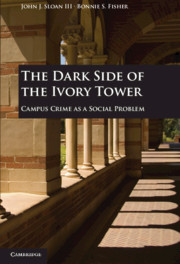Book contents
- Frontmatter
- Contents
- Preface
- Acknowledgments
- The Dark Side of The Ivory Tower
- Chapter One Violence, Vice, and Victimization on American College and University Campuses
- Chapter Two Constructing Campus Crime as a New Social Problem
- Chapter Three Constructing Unsafe and Violent College Campuses
- Chapter Four Constructing the Sexual Victimization of College Women on Campus
- Chapter Five Constructing Postsecondary Institutional Liability for Campus Crime
- Chapter Six Constructing Binge Drinking on College Campuses
- Chapter Seven The Legacy of Claimsmakers
- Index
- References
Chapter Three - Constructing Unsafe and Violent College Campuses
Published online by Cambridge University Press: 05 June 2012
- Frontmatter
- Contents
- Preface
- Acknowledgments
- The Dark Side of The Ivory Tower
- Chapter One Violence, Vice, and Victimization on American College and University Campuses
- Chapter Two Constructing Campus Crime as a New Social Problem
- Chapter Three Constructing Unsafe and Violent College Campuses
- Chapter Four Constructing the Sexual Victimization of College Women on Campus
- Chapter Five Constructing Postsecondary Institutional Liability for Campus Crime
- Chapter Six Constructing Binge Drinking on College Campuses
- Chapter Seven The Legacy of Claimsmakers
- Index
- References
Summary
The impact of crime on college and university campuses has increased dramatically. The Columbine High School tragedy confronts all educational institutions with the previously unimaginable possibility that members of our campus communities are capable of planning and carrying out…a brutal massacre of students, faculty and administrators.
While the spree murders that occurred at Virginia Tech and Northern Illinois University raised serious public concerns over the safety of college and university students in the United States, campus violence is hardly new. With some exceptions during the 1960s, media coverage of violence on college campuses during the 20th century generally took a matter-of-fact tone. That is, the facts of these incidents were reported – who, what, where, and when – along with observations from various commentators on both sides of the larger gun control debate. However, claims about these incidents serving as a harbinger of bigger problems were largely absent.
Beginning in the 1980s and continuing into the 1990s, however, a change occurred in the tone of mass-media coverage of campus violence. What had been relatively routine reports of serious criminal incidents on college campuses now began including language hinting that something alarming was occurring that put millions of college students at risk of becoming the victims of serious violence – including murder. For example, a 1981 story appearing in the New York Times indicated that “violence was becoming a way of life for students” and that “large numbers” of students involved in romantic relationships were “physically abusing their partners.” Similarly, a 1984 New York Times story indicated that rioting by college students after athletic contests or when large parties were broken up by police was becoming common on college campuses.
- Type
- Chapter
- Information
- The Dark Side of the Ivory TowerCampus Crime as a Social Problem, pp. 52 - 80Publisher: Cambridge University PressPrint publication year: 2010



